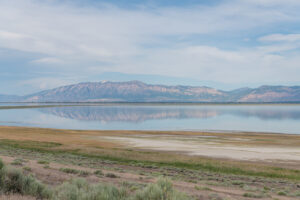Utah is growing. Fast. As Utah continues its meteoric rise, the demand for accessible and affordable housing and commercial buildings continues to compound. This growth also means new energy demands, and with it, pollution. We need smart public policy to manage this growth. As luck would have it, an opportunity is around the corner that, if seized, will unlock millions of dollars in energy savings, while also bolstering affordable housing, cleaner air, and local climate solutions here in Utah.
Building codes set the minimum standards for new construction and major renovations, and every few years, the state of Utah considers updates to our building codes. This impacts, among other things, the energy performance of our homes and buildings. The question remains, will the Utah Legislature opt to update Utah’s building code?
It is time to update Utah’s out-of-date energy code
All updated building codes bring benefits to Utahns, but Utah Clean Energy is especially interested in the 2021 energy code (called the International Energy Conservation Code, or the “IECC”). This code focuses on ensuring homes and buildings are not needlessly wasting energy while increasing comfort, making buildings more affordable to operate, and cutting climate emissions and local pollution. Unfortunately, Utah builders are working from out-of-date versions of the IECC – our residential energy code is based on the 2015 IECC, and our commercial code is the 2018 IECC. Using outdated energy codes is a missed opportunity to save energy and reduce pollution in Utah. It’s time to remedy this!
A recognized air quality and climate tool
Reducing emissions from our homes and buildings is a recognized solution to Utah’s air quality and climate challenges. Reports by the Kem C Gardner Policy Institute, and most recently, the Utah Foundation, have both identified updated energy codes and energy efficiency, as well as electrification as high-priority, cost-effective solutions to dramatically reduce pollution in Utah.
The data is in!
Recently-published residential and commercial cost-effectiveness analyses from the Pacific Northwest National Laboratory, and a recent study about the residential 2021 energy code from Nexant, each show positive economic and environmental impacts from adopting the updated 2021 energy codes. This data provides a clear view of the benefits to Utah families and businesses.
Questions & Answers about the Updated 2021 Energy Code in Utah
Q: How will the updated energy codes impact affordability for new homes and buildings in Utah?
A: Homeowners are expected to save approximately $150 each year in energy bills, after accounting for an increased down payment and monthly mortgage costs. Over the life of the home, homeowners will save approximately $6,000.
Q: How does an updated energy code impact low- and moderate-income Utahns?
A: Energy codes are critical to ensuring affordable energy bills for new homes, especially for low- and moderate-income residents. While an average household spends 3.5% of their household income on energy bills, low-income households spend twice as much — an average of 7%. Energy burdens pose even greater challenges for extremely low-income families; Salt Lake County families who have an annual income of $24,600 for a family of 4 spend a staggering 21% of their income on energy (source). Adopting the 2021 IECC in Utah will help tackle high energy burdens for Utah’s low- and moderate-income families as Utah continues to prioritize affordable housing.
Q: How does the updated energy code impact new commercial buildings?
A: According to the PNNL report, new commercial buildings, both private and public, would cost less to build under the newest energy standard. Specifically, the study estimates that across the state for all building types, new commercial buildings would cost about $1.07 per square foot less to build. New commercial buildings are expected to be cheaper to construct due to things like the need for fewer light fixtures and smaller HVAC units that result efficiency gains from building envelope improvements.
On top of this, the efficiency gains from the newest commercial energy code would cut energy costs by $0.042 per square foot on average for all building types across Utah.
Q: How will updating Utah’s energy codes benefit our air quality and address climate change?
A: According to the Nexant study, each new home constructed to the 2021 energy code will reduce its carbon footprint by an estimated 1-2 tons of CO2 per year. Statewide, according to PNNL, this translates to close to 19,000 metric tons of CO2 in the first year alone! In total, the updated residential energy code will prevent over 9 million metric tons of carbon dioxide emissions over 30 years.
Constructing commercial buildings to the newest energy standard is estimated to cut CO2 emissions statewide by over 7,600 metric tons of CO2 per year and 5.3 million metric tons over 30 years.
In total, if Utah updates its residential and commercial energy code, we could cut annual CO2 emissions by over 26,000 metric tons and keep almost 14.5 million metric tons of CO2 out of our atmosphere over the next 30 years. To put these numbers into perspective, this is equivalent to the GHG emissions avoided from taking over 5,700 passenger cars off the road per year, or 3 million gallons of gasoline NOT being consumed each year or planting 436,000 trees annually.
Q: Does constructing a home or building to the newest energy code cost more?
A: Yes, and at the same time, no. As with most energy efficiency improvements, there are associated up-front costs. In this case, the incremental construction cost is approximately $4,000 for a single-family home. However, by using the buying power of a mortgage and spreading those costs out over the life of the loan, the energy savings exceed the new mortgage costs. So, in terms of whole-house cost, the cost of owning and operating a home built to the updated code does not cost more. In fact, it increases home affordability while also improving comfort and reducing emissions!
Q: Does the 2021 energy code include any provisions to help the industry adopt innovative building practices?
A: Across the country and here in Utah more and more new buildings are being built as “zero energy” or “net zero” buildings. This means that buildings are highly energy efficient and utilize on-site or off-site renewable energy to provide 100% of the building’s energy needs. The 2021 IECC includes two exciting new provisions that will create a voluntary, code-based pathway for zero energy buildings. The residential code includes Appendix RC Zero Energy Residential Building Provisions and the commercial chapter of the 2021 IECC includes Appendix CC Zero Energy Commercial Building Provisions. The appendices are voluntary but are really important to help the industry become familiar with strategies to reach net zero.
Q: How soon would these changes take effect?
A: The soonest that the updated energy code would be required for new construction would be summer 2023.
Q: How does the updated energy code support local jobs?
A: The Pacific Northwest National Laboratory estimates that over 800 jobs will be created in the first year following updated energy code adoption, with over 23,600 jobs created over 30 years! The reports estimate that improved efficiency will support job creation in two ways: (1) through reduced utility bills, which translates directly into more disposable income in the economy, and (2) an increase in construction-related activities that results from these newer standards.
Q: How can Utahns get involved?
A: Utah’s Uniform Building Code Commission is currently reviewing the 2021 building codes and is required to make its recommendations to the Utah State legislature no later than September of 2022. The Commission’s meetings are open to the public and interested community members can send comments to the Commission and attend the commission’s required public hearing to voice your support for updated energy codes. Sign up for the Commission’s public meeting notices here (search “State” > “Department of Commerce” > Uniform Building Code Commission”) and stay tuned to Utah Clean Energy’s e-newsletter, social media accounts, and website to stay apprised of key dates!






